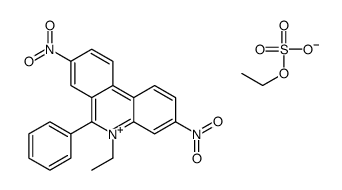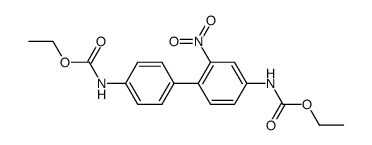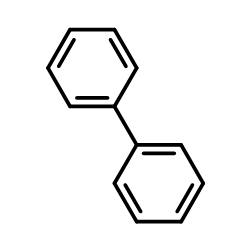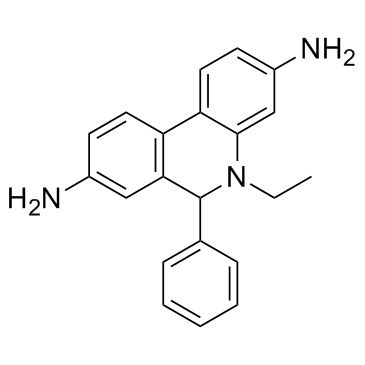Ethidium bromide

Ethidium bromide structure
|
Common Name | Ethidium bromide | ||
|---|---|---|---|---|
| CAS Number | 1239-45-8 | Molecular Weight | 394.308 | |
| Density | N/A | Boiling Point | N/A | |
| Molecular Formula | C21H20BrN3 | Melting Point | 260-262 °C (dec.)(lit.) | |
| MSDS | Chinese USA | Flash Point | >100°C | |
| Symbol |


GHS06, GHS08 |
Signal Word | Danger | |
Use of Ethidium bromideEthidium bromide is an intercalating agent commonly used as a fluorescent tag (nucleic acid stain) in molecular biology laboratories for techniques such as agarose gel electrophoresis. |
| Name | ethidium bromide |
|---|---|
| Synonym | More Synonyms |
| Description | Ethidium bromide is an intercalating agent commonly used as a fluorescent tag (nucleic acid stain) in molecular biology laboratories for techniques such as agarose gel electrophoresis. |
|---|---|
| Related Catalog | |
| In Vitro | Guidelines (Following is our recommended protocol. This protocol only provides a guideline, and should be modified according to your specific needs). The preparation of agarose gel: 1. Agarose gels are commonly used in concentrations of 0.5% to 2.5% depending on the size of bands needed to be separated. 2. Mix the agarose powder with 1X TAE/TBE. 3. Microwave for 1-3 min until the agarose is completely dissolved (Caution: not overboil). 4. Make the solution cool down before solidification. 5. Add ethidium bromide (EtBr) to a final concentration of approximately 0.2-0.5 μg/mL (Stocks are generally 10 mg/ml, and require 5 µL stock/100 mL gel). 6. Ethidium bromide binds to the DNA and you could visualize the DNA under ultraviolet (UV) light. CAUTION: EtBr is a known mutagen. Please pay attention to strengthening protection. |
| References |
| Melting Point | 260-262 °C (dec.)(lit.) |
|---|---|
| Molecular Formula | C21H20BrN3 |
| Molecular Weight | 394.308 |
| Flash Point | >100°C |
| Exact Mass | 393.084045 |
| PSA | 55.92000 |
| LogP | 2.29820 |
| Index of Refraction | 1.4575 (20ºC) |
| InChIKey | ZMMJGEGLRURXTF-UHFFFAOYSA-N |
| SMILES | CC[n+]1c(-c2ccccc2)c2cc(N)ccc2c2ccc(N)cc21.[Br-] |
| Storage condition | 2-8°C |
| Stability | Stable. Incompatible with strong oxidizing agents. |
| Water Solubility | 40 g/L (25 ºC) |
CHEMICAL IDENTIFICATION
HEALTH HAZARD DATAACUTE TOXICITY DATA
MUTATION DATA
|
| Symbol |


GHS06, GHS08 |
|---|---|
| Signal Word | Danger |
| Hazard Statements | H302-H330-H341 |
| Precautionary Statements | P260-P281-P284-P310 |
| Personal Protective Equipment | Eyeshields;Faceshields;full-face particle respirator type N100 (US);Gloves;respirator cartridge type N100 (US);type P1 (EN143) respirator filter;type P3 (EN 143) respirator cartridges |
| Hazard Codes | T+:Verytoxic; |
| Risk Phrases | R21/22;R26;R36/37/38;R68 |
| Safety Phrases | S36/37-S45-S36/37/39-S28A-S26-S22 |
| RIDADR | UN 2811 6.1/PG 1 |
| WGK Germany | 3 |
| RTECS | SF7950000 |
| Packaging Group | I |
| Hazard Class | 6.1 |
| HS Code | 29339990 |
| Precursor 9 | |
|---|---|
| DownStream 1 | |
| HS Code | 2933990090 |
|---|---|
| Summary | 2933990090. heterocyclic compounds with nitrogen hetero-atom(s) only. VAT:17.0%. Tax rebate rate:13.0%. . MFN tariff:6.5%. General tariff:20.0% |
|
L. monocytogenes in a cheese processing facility: Learning from contamination scenarios over three years of sampling.
Int. J. Food Microbiol. 189 , 98-105, (2014) The aim of this study was to analyze the changing patterns of Listeria monocytogenes contamination in a cheese processing facility manufacturing a wide range of ready-to-eat products. Characterization... |
|
|
Alpha-fetoprotein, identified as a novel marker for the antioxidant effect of placental extract, exhibits synergistic antioxidant activity in the presence of estradiol.
PLoS ONE 9(6) , e99421, (2014) Placenta, as a reservoir of nutrients, has been widely used in medical and cosmetic materials. Here, we focused on the antioxidant properties of placental extract and attempted to isolate and identify... |
|
|
Vegetables' juice influences polyol pathway by multiple mechanisms in favour of reducing development of oxidative stress and resultant diabetic complications.
Pharmacogn. Mag. 10(Suppl 2) , S383-91, (2014) Hyperglycemia induced generation of free radicals and consequent development of oxidative stress by polyol pathway is one of the crucial mechanisms stirring up development of diabetic complications. W... |
| 3,8-Diamino-5 |
| MFCD00011724 |
| 3,8-Diamino-5-ethyl-6-phenylphenanthridinium bromide,EtBr,Homidium bromide |
| Phenanthridinium, 3,8-diamino-5-ethyl-6-phenyl-, bromide (1:1) |
| Homidium bromide |
| 3,8-Diamino-5-ethyl-6-phenylphenanthridin-5-ium bromide |
| 3,8-Diamino-5-ethyl-6-phenylphenanthridinium bromide |
| EINECS 214-984-6 |
| 5-ethyl-6-phenylphenanthridin-5-ium-3,8-diamine,bromide |
| EthidiuM BroMide |
 CAS#:93840-65-4
CAS#:93840-65-4 CAS#:52671-22-4
CAS#:52671-22-4 CAS#:2243-78-9
CAS#:2243-78-9 CAS#:71857-96-0
CAS#:71857-96-0 CAS#:71857-87-9
CAS#:71857-87-9 CAS#:62895-39-0
CAS#:62895-39-0 CAS#:92-87-5
CAS#:92-87-5 CAS#:92-52-4
CAS#:92-52-4 CAS#:86-00-0
CAS#:86-00-0 CAS#:104821-25-2
CAS#:104821-25-2
